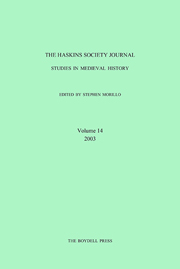Book contents
- Frontmatter
- Contents
- List of Illustrations
- Editorial Note
- Abbreviations
- 1 Even the Devil (Sometimes) has Feelings: Emotional Communities in the Early Middle Ages
- 2 Alcuin, Willibrord, and the Cultivation of Faith
- 3 Henry Loyn Memorial Lecture: English Identity from Bede to the Millennium
- 4 The ‘Farm of One Night’ and the Organisation of Royal Estates in Late Anglo-Saxon Wessex
- 5 Changing Fortunes: Edwardian Anglo-Jewry and their Credit Operations in Late Thirteenth-Century England
- 6 Forty Acres and a Mule: the Mechanics of English Settlement in Northeast Wales after the Edwardian Conquest
- 7 Consanguinity and the Saint-Aubin Genealogies
- 8 Widows, Religious Patronage and Family Identity: Some Cases from Twelfth-Century Yorkshire
- 9 Desecration and Consecration in Norman Capua, 1062–1122: Contesting Sacred Space during the Gregorian Reforms
- 10 From Ego to Imago: Mediation and Agency in Medieval France (1000–1250)
6 - Forty Acres and a Mule: the Mechanics of English Settlement in Northeast Wales after the Edwardian Conquest
Published online by Cambridge University Press: 05 September 2014
- Frontmatter
- Contents
- List of Illustrations
- Editorial Note
- Abbreviations
- 1 Even the Devil (Sometimes) has Feelings: Emotional Communities in the Early Middle Ages
- 2 Alcuin, Willibrord, and the Cultivation of Faith
- 3 Henry Loyn Memorial Lecture: English Identity from Bede to the Millennium
- 4 The ‘Farm of One Night’ and the Organisation of Royal Estates in Late Anglo-Saxon Wessex
- 5 Changing Fortunes: Edwardian Anglo-Jewry and their Credit Operations in Late Thirteenth-Century England
- 6 Forty Acres and a Mule: the Mechanics of English Settlement in Northeast Wales after the Edwardian Conquest
- 7 Consanguinity and the Saint-Aubin Genealogies
- 8 Widows, Religious Patronage and Family Identity: Some Cases from Twelfth-Century Yorkshire
- 9 Desecration and Consecration in Norman Capua, 1062–1122: Contesting Sacred Space during the Gregorian Reforms
- 10 From Ego to Imago: Mediation and Agency in Medieval France (1000–1250)
Summary
‘[Thomas] de Clare had built a castle of dressed stone, girt with [a] thick outer wall, containing a roofed impregnable donjon, and having capacious lime-whited appurtenances; this settlement then he, with common English so many as by bribes and purchase he was able to retain, proceeded to inhabit … and after expulsion of the ancient dwellers on the soil [around] … he assigned that region to plebeian English.’ Although an account of English activities in Ireland in the late-thirteenth century, this excerpt from The Triumphs of Turlough also encapsulates the two crucial phases of settlement in contemporary Wales: the establishment of a castle, and the firm planting of both an urban and a rural immigrant community. Nowhere in Wales can this process be traced as minutely as in the lordships of Denbigh and Ruthin, both created after the final English conquest in 1282–83.
After his successful campaigns in North Wales in 1277 and 1282–83, Edward I divided the spoils of battle, huge tracts of land in northeast Wales, among his trusted followers. Of this land, the fertile region bordering the river Clwyd contained the most valuable soil in the region, and it is no surprise that it was gifted to two of Edward's most capable leaders: Henry de Lacy, earl of Lincoln, and Reginald de Grey. On 16 October 1282, de Lacy received over 68,000 acres of prime real estate in northeast Wales in what was to be known as the lordship of Denbigh, an area roughly equivalent to a small English county.
- Type
- Chapter
- Information
- The Haskins Society Journal 142003. Studies in Medieval History, pp. 91 - 104Publisher: Boydell & BrewerPrint publication year: 2005

